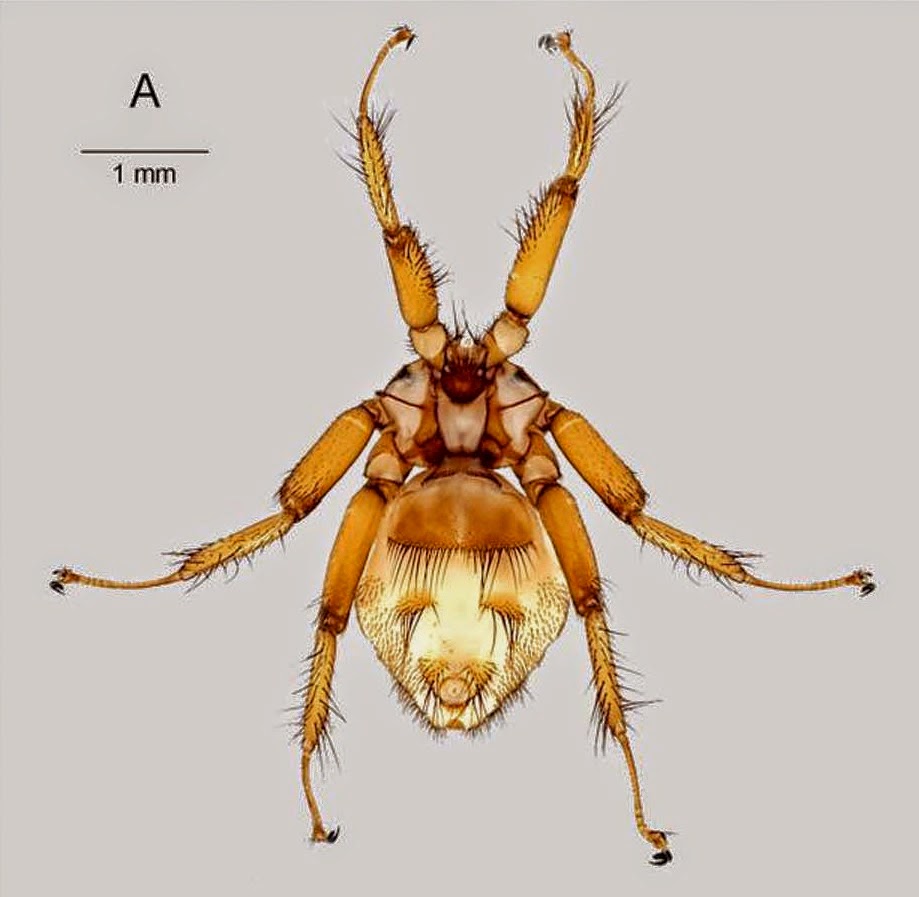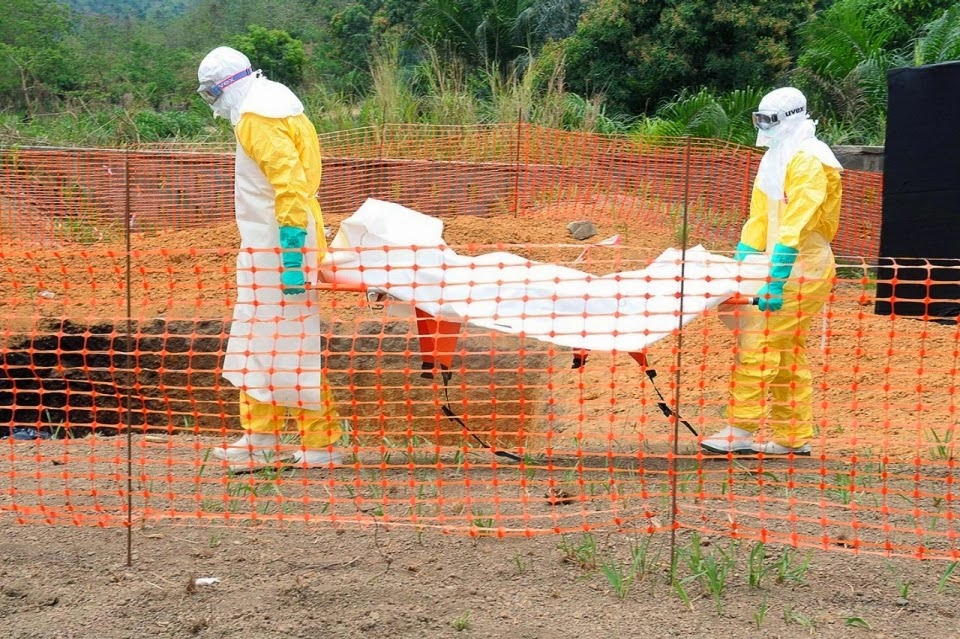In December 2013 cases of the haemorrhagic Virus Ebola began to be
reported from the village of Meliandou near Guéckédou in the Republic of
Guinea. As is typical of the disease, it quickly overwhelmed local healthcare
facilities, where unprepared staff where among the first infected. Since this
initial outbreak the disease has spread to Sierra Leone, Liberia, Nigeria,
Senegal, USA, Spain, and Mali, with 17 145
reported cases and 6070 recorded deaths, as of 3 December 2014; the
worst outbreak of the disease since records began. The outbreak has been
confirmed to be of the Zaire Ebola Virus, EBOV, the most lethal of the five
known Ebola Viruses, which typically kills around 88% of people who become
infected but do not receive treatment.
Ebola Viruses are thought to be zoonotic in origin (i.e. present in
a population of animals, with only occasional, opportunistic infections of
Humans) as its high fatality rate prevents the establishment of a permanent
viral reserve in the Human population. The animal vector for the disease is
still not known; non-Human Primates and Duikers (small, forest-dwelling
Antelopes) have both been suggested as possible vectors for the disease, as
these animals are also susceptible to the Virus, however these animals suffer
levels of mortality similar to that seen in Humans, making them unlikely
permanent hosts for the disease.
Bats have also been suggested as a possible vector for the disease,
and several species have been shown to be able to survive Ebola infections
(notably the Fruit Bat Epomophorus
wahlbergi and the Insectivorous Bats Chaerephon
pumilus and Mops condylurus),
while Ebola RNA has been recovered from three species of Fruit Bat (Epomops franqueti, Hypsignathus monstrosus, and Myonycteris
torquata) and antibodies to the Virus from a wide range of Bats (Epomops franqueti, Hypsignathus monstrosus, Myonycteris
torquata and Mops condylurusagain,
plus Eidolon helvum, Epomophorus gambianus, Micropteropus pusillus, Rousettus aegyptiacus, and Rousettus leschenaultia). Fruit Bats are
widely eaten as Bushmeat in Africa, and it has been suggested that the
preparation and consumption of Fruit Bats may be the cause of Ebola outbreaks
in Human populations.
In a paper published in the journal EMBO Molecular Medicine on 30
December 2014, a team of scientists led by Almudena Marí Saéz of Institute ofTropical Medicine and International Health at the Charité UniversitätsmedizinBerlin describe the results of a survey of the wildlife around Meliandou with
the intention of determining the vector for the Virus.
Sampling and investigation locations for the 2014
Ebola-related animal survey. (A) In southeastern Guinea (Sierra Leone, Guinea,
and Liberia are visible), scale bar stands for 50 km. (B) In and around the
index village, Meliandou, scale bar stands for 100 m. Marí Saéz et al. (2014).
Primate meat is occasionally consumed in Meliandou, but is not
usually caught locally, typically arriving as smoked meat from the Fouta
Djallon region of northwest Guinea. This makes it an unlikely source of
infection, as the Virus would have been required to reach the village in
treated meat without infecting the original hunters, food processors or traders
in the supply route. Nor are wild Primates typically found close to the
village. Wild Primates, including Chimpanzees (Pan troglodytes verus) are found in two reserves in southern
Guinea, Massif du Ziama and Fôrét classée de Diéké, however neither of these
are close to Meliandou, and in neither location do the Apes show any signs of a
population crash, which is typical of Ebola infections in Great Ape
populations. This is in contrast to the situation following previous Ebola
epidemics in Equatorial Africa, when Apes have been as badly affected as
Humans.
Bats, however, are occasionally hunted around Meliandou, with men
from the village and neighbouring communities regularly targeting Fruit Bats as
a source of food year round, and both local hunters and government officials in
the area reporting large Bat colonies in the area. In addition large groups of
migratory Fruit Bats visit the area each year, and a large colony of
wide-ranging Fruit Bats is present in a cave system in the Ziama Biosphere
Reserve. Insectivorous Bats are also common in the area, frequently roosting
under the eves of houses, where they are hunted by children, who grill them
over small fires (hunting of small game by children is common in Guinea and
neighbouring countries).
The village of Meliandou. Marí Saéz et al. (2014).
Marí Saéz et al. trapped
169 Bats belonging to thirteen species at four sights in southern Guinea (Meliandou,
Kagbadou, Kéléma, and Ziama, including members of three species previously
recorded to carry the Virus (Eidolon
helvum, Hypsignathus monstrosus,
and Mops condylurus). However neither
Ebola RNA nor antibodies to the Virus could be recovered from any of these.
The first reported case of Ebola in Meliandou was a two-year-old
boy, unlikely to have participated in hunting of Bats of any kind. Furthermore
the boy’s father did not live in the village, and did not participate in
hunting, making it unlikely that he had brought bats into the home. In order to
try understand how the initial infection occurred Marí Saéz et al. carried out a detailed survey of
the village, which comprised 31 houses, and its surroundings, farmland with a
few large trees.
A large burned hollow tree stump was found about 50 m to the south
of the house where the initial infection occurred, on the route from the
village to a river used by local women to wash laundry. Villagers reported that
children had frequently played in this tree, and that the tree had caught fire
in March 2014, which resulted in a ‘rain of Bats’ falling from the tree. The
Bats were described as lolibelo, which does not correspond to an exact species
in the Linnean sense, but which could imply a number of small, long-tailed Bat
species. After the fire the villagers collected the dead Bats with the
intention of consuming them, but received notice of a ban on bushmeat
consumption as part of a range of environmental health measures intended to
combat the disease outbreak the following day, and disposed of the animals.
Screening ash and soil samples from beneath the tree recovered DNA assigned
confidently to Mops condylurus, a
small insectivorous Bat, known to be able to survive Ebola infection, which is
considered a possible reservoir for the disease.
The burnt hollow tree; in (D), the arrow points at a
stick, most probably left there by children. Marí Saéz et al. (2014).
Marí Saéz et al. conclude
that Bats are very likely to have been the Virus reservoir for the 2013
December 2013 Guinean Ebola outbreak, but caution that care needs to be taken
in how this data is interpreted. Previous attempts at arranging Bat culls to
control zoonotic diseases have been unsuccessful and sometimes resulted in Bats
scattering to avoid being killed and carrying the disease to new areas. Bats
also perform a number vital ecosystem services, including distributing seeds,
pollinating some plants and controlling Insect populations. They therefore
council that future public health initiatives should concentrate on highlighting
the dangers of Bat handling, but seek to avoid promoting conflicts between
Human and Bat populations. In addition they feel that future discussion of the
cause of the outbreak should stress that while the initial infection occurred
in Meliandou, this was essentially down to bad luck and great care should be
taken to avoid the stigmatization of people from the village or the wider south
Guinea area.
See also…
 Nycteribiid Bat Flies from the southwest Indian Ocean. Nycteribiid Bat Flies are True Flies, Diptera, that have lost their
wings and adopted a lifestyle as ectoparasites of Bats. They have an unusual
lifestyle, with the larva maturing within the female Fly (which only produces
one larva at a time), then being ‘laid’ during the pupa stage. The female Fly
leaves her host Bat to lay this pupa, which hatches 3-4 weeks later, producing
a new adult...
Nycteribiid Bat Flies from the southwest Indian Ocean. Nycteribiid Bat Flies are True Flies, Diptera, that have lost their
wings and adopted a lifestyle as ectoparasites of Bats. They have an unusual
lifestyle, with the larva maturing within the female Fly (which only produces
one larva at a time), then being ‘laid’ during the pupa stage. The female Fly
leaves her host Bat to lay this pupa, which hatches 3-4 weeks later, producing
a new adult... At least 467 dead in West African Ebola outbreak. At least 467 people have died in an outbreak of Ebola Hemorrhagic Fever
in West Africa that began in February this year. The disease initially
appeared in the remote border area between Guinea, Sierra Leone...
At least 467 dead in West African Ebola outbreak. At least 467 people have died in an outbreak of Ebola Hemorrhagic Fever
in West Africa that began in February this year. The disease initially
appeared in the remote border area between Guinea, Sierra Leone...
The Earth has suffered a decline in biodiversity over the past century
unprecedented in human history. This has led to a concerted effort to
monitor populations of animals in many of the world’s threatened...
Follow Sciency Thoughts on Facebook.




